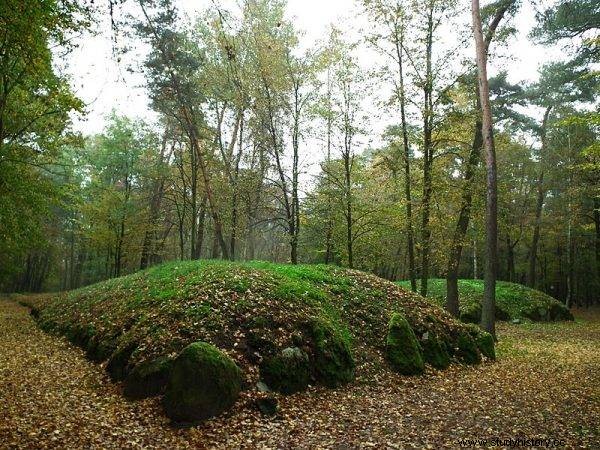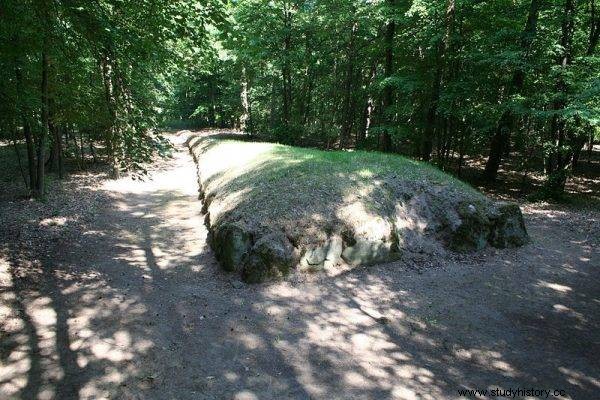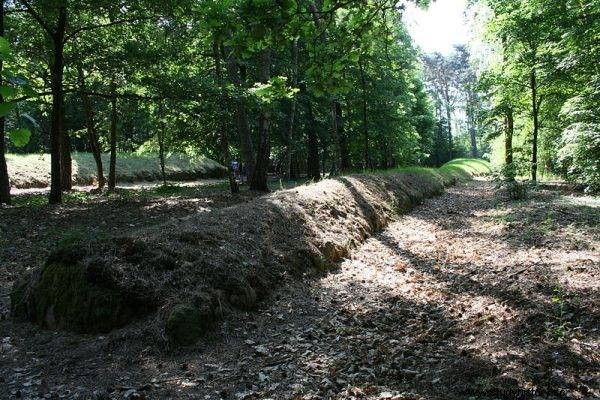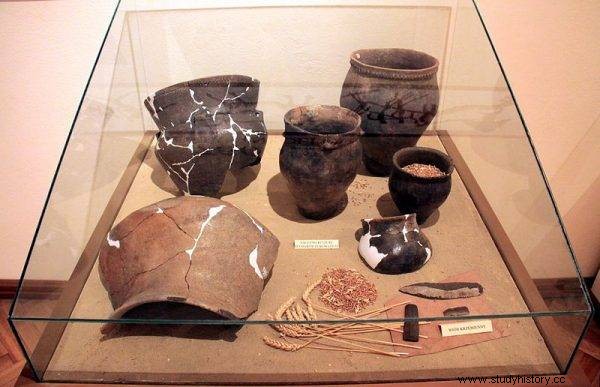5500 years ago, the areas of today's Poland were dotted with huge megalithic structures, older than the Egyptian pyramids and the British circle of Stonehenge boulders. The remains of giant buildings are the heritage of people living here in the Neolithic era, at a time when man began to subjugate the surrounding nature. He learned to farm, build settlements - as well as large stone objects ...
Wietrzychowice and Sarnowo in Kujawy. This includes here are the oldest man-made buildings in Poland that have survived to this day. We are talking about great megalithic tombs. They are sometimes called Kuyavian tombs or the graves of giants - because in the old days it was believed that giants, not people, built these massive structures.
It is estimated that the tombs were built around the middle of the fourth millennium BC. Megaliths were erected on the plan of an elongated triangle or trapezoid. They were up to 150 meters long. The height was several meters. The building blocks were huge, sometimes several tons of boulders.
Men's business
How did the people of the Stone Age manage to move such heavy material to the construction site? Well, undoubtedly finding the huge boulders was a long and demanding process. The stones often had to be removed from the ground and then delivered to the site. Researchers believe that the carts that were already known then were not used for this - their construction would not be able to withstand the transport of such a weight. Perhaps the boulders were dragged by oxen on sled-like surfaces.
Scientists emphasize that the buildings were characterized by a well-thought-out, conscious construction. The boulders were placed compactly, very close to each other, with a smoother surface on the outside. The faces of the tombs were always facing east . There, too, at the base, the widest, largest boulders were mounted. Gradually, the long tomb narrowed and decreased in size. As much as 400-600 massive stones and hundreds of tons of earth were used to build one.

Megalithic tombs in Wietrzychowice.
Scientists discovered the so-called mortuary temples. In Krzysztof Paluszyński's documentary “Megaliths. History from 5500 thousand years ago "archaeologist prof. Jacek Wierzbicki explains:
In the stones of the tomb's forehead, there was a small gap through which you entered the mortuary temple, and only further, behind this temple, in the depth to the west was the tomb of this tomb the deceased, who was always a man.
The mortuary temples inside the earth embankment were built of wood. The structure was covered with earth. The temple ground, on the other hand, was a very carefully prepared clay (sometimes burnt) surface.
Scientists speculate that the temples were used for funeral rites, but not only. Perhaps other rituals important for the community took place there, and the earth embankments themselves were centers of worship for several or a dozen nearby settlements.
Posthumous honor
In the depths of the tomb, behind the temple, the body of the "owner" of the tomb was laid. Who was? The honor of such an exceptionally impressive burial, requiring a huge amount of effort and time, belonged only to men. It was probably the chief or religious leader of the tribe, perhaps a priest. Prof. Wierzbicki in the movie "Megaliths" explained:
They were men in the advanced, mature for the Neolithic age - about 40-50 years . On their last journey into the afterlife, little equipment was put into their tombs. It is mainly about prestigious items, such as an ax with a button-like head, or a flint or copper dagger.

The tombs were called the tombs of the giants.
Interestingly, the population of the Funnel Beaker Culture cultivated and processed poppy seeds. Popular vessels from that period were small clay "bottles", called by researchers flasks with a ruff, resembling a poppy seed. Scientists speculate that they were used to store poppy seed products. Such vessels were also often placed with the dead in huge stone graves as part of their earthly "furnishings" in the afterlife.
Giant signposts
Why did Neolithic people build such structures? According to the researchers, it was not only about commemorating, paying tribute to the chief or other significant entity. The mighty megaliths were also a symbol of the unity of the community that created them. Behind them was the organization of society, the division of roles and work.
They could also testify to military and magical strength. If a given community was able to build such large structures, it meant that there were enough men living in it ready to fight when needed. It is possible, however, that the tombs had other roles as well. Research from Germany suggests that they arose along important trade routes. Perhaps they were the points of reference in the system of exchange between groups of the population.
The best-preserved "Polish pyramids" have survived to this day in Kujawy and Pomerania and Western Pomerania, however, according to researchers, several thousand years ago, entire stretches of the country were dotted with hundreds of such structures. Unfortunately, most of them were destroyed in the 19th and 20th centuries.

Several thousand years ago, entire stretches of the country were dotted with hundreds of such structures. Unfortunately, most of them were destroyed in the 19th and 20th centuries.
Currently, thanks to modern research methods, such as aerial laser scanning, more and more similar megalithic objects are revealed. This was the case with forests in the Konin County in Greater Poland, where a dozen "new" megaliths were discovered.
On the other hand, in Dolice in Western Pomerania, the actual shape of a megalithic tomb, already known from pre-war times, has been revealed in recent years. It turned out that the structure was 70 meters long, so it was much larger than originally thought. It is estimated that only in the area between Dolice, Pyrzyce and Stargard, in the West Pomeranian Voivodeship, near Szczecin, there were even 200 megalithic tombs.
Lords of nature
Who were those who built these mighty structures? The so-called Funnelbeaker culture is one of the Neolithic cultures occurring in Poland. Its representatives lived from around the 4th millennium BC throughout Poland, as well as in southern Scandinavia, north-eastern Germany and western Ukraine.
It was during the Neolithic, which began in Poland around the middle of the 6th millennium BC, that people abandoned their wandering lives and began to subjugate nature. Research shows that representatives of the Funnel Beaker Culture did not come from nowhere to the Vistula and Oder rivers. This is where this culture was "born". The name comes from its characteristic product, namely dishes with a widely flared, "funnel-shaped" collar.
However, these people left behind much more - incl. stone and flint tools, ceramics, agricultural equipment. Extremely useful and widely used flint has been learned to extract on a large scale from mines, among others in Krzemionki Opatowskie. Scientists estimate that flint products were traded over 600 km from the place where they were made.

Dishes of the Funnel Beaker Culture found in Pełczyska, on display at the Wielopolski Palace in Chroberz.
To cultivate the land, they used a planter pulled by cattle. One of the most important remains of those former inhabitants of Poland, apart from the so-called of the graves of the giants, there is a vase from Bronocice - now located in the Archaeological Museum in Krakow. On the walls of the vessel dated around 3635-3370 BC a prehistoric artist made drawings that, according to scientists, depict a wheeled vehicle . This picture of a cart on four wheels is considered to be the oldest representation of this - extremely important for human development - construction in the world.
This, in turn, means that over 5,500 years ago people in our part of the world knew about transportation vehicles. Interestingly, they probably used rounds as draft cattle. Along with the vase from Bronocice, the remains of these animals were also found. Their horns had abrasions that may indicate that they were being yoked primitive to the side.
Finally, the most spectacular of the finds, i.e. successive megaliths created by this culture, indicate that these people long before the birth of civilization already had a well-developed organization of work, social and political system, ideology and spiritual-religious life.
Today - incl. thanks to modern research methods - we know more and more about the oldest settled inhabitants of Polish lands. It should be assumed that more remnants of mysterious dark stone structures will be revealed soon, not created by giants, but by human hands.
Bibliography:
- Jared Diamond: Shotguns, germs, machines. The fate of human societies . Warsaw:Prószyński i S-ka 2000.
- Konrad J jazdewski, Culture of Funnel Beakers in Western and Central Poland , Poznań 1936.
- Aleksandra Cofta-Broniewska, Aleksander Kośko, Primary history of the Kujawy societies , Warsaw - Poznań 1982.
- Krzysztof Kębiek:"The cursed antiquity. Archeologists and sensation hunters ”, Attyka Publishing House, Warsaw 2008.
- Janusz Ostoja-Zagórski, The most ancient history of the Polish lands , Bydgoszcz 2005.
- Adam Ziółkowski: Historia Powszechna. Antiquity . Warsaw:PWN 2009.
Filmography:
- "Megaliths. A history from 5500 years ago ”, dir. Krzysztof Paluszyński
